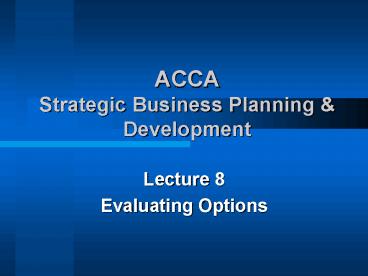ACCA Strategic Business Planning - PowerPoint PPT Presentation
1 / 22
Title:
ACCA Strategic Business Planning
Description:
Be able to quantify decision making-techniques with use of decision ... Changing the target return to reflect riskiness of project. Adjusting the payback period ... – PowerPoint PPT presentation
Number of Views:76
Avg rating:3.0/5.0
Title: ACCA Strategic Business Planning
1
ACCA Strategic Business Planning Development
- Lecture 8
- Evaluating Options
2
Learning Outcomes CHECK
- By the end of this lecture you will
- Understand the need for evaluation
- Have developed a framework for the evaluation and
selection of strategies - Be able to quantify decision making-techniques
with use of decision matrices and sensitivity
analysis - Understand the reasons for considering
stakeholders view in deciding strategies
3
Evaluation Criteria
- Suitability
- does the strategy address the key issues
identified in the strategic analysis? - useful for screening choices (often qualitative)
- Feasibility
- can the strategy be made to work in practice?
- focus on practicalities of resourcing
- Acceptability
- are the expected outcomes acceptable? (To whom?)
- stakeholder analysis important
4
Suitability
- Does it exploit strengths?
- Does it rectify weaknesses?
- Does it neutralise threats?
- Does it seize opportunities?
- Does it satisfy organisational goals?
- Does it fill any identified gaps?
- Does it generate/maintain competitive advantage?
- Does it involve an acceptable level of risk
- Does it suit the politics and corporate culture?
5
STAGES OF INDUSTRY MATURITY
COMPETITIVE POSITION
Source Arthur D. Little
The Life Cycle/Portfolio Matrix
6
Feasibility
- Can the strategy be implemented and does the
organisation have adequate resources? - Enough money
- The ability to deliver the goods/services
- The ability to deal with competitor responses
- Access to technology, materials and resources
- Enough time
7
Acceptability
- Financial considerations
- ROI etc.
- Profitability analysis, e.g. NPV
- Customers
- Banks
- Government
- The public
- Risk
8
Financial Evaluation
- Investment outflows up front and in the future
(discounted) - Revenue inflows (discounted)
- Compare with cost of capital, target ROI/ROCE
- Shareholders objectives, e.g. target EPS
- Closing the planning gap
9
Ranking and Cost/Benefit Analysis
- Ranking and Scoring methods are a means of adding
opinions to give weighted and importance to
strategies - Cost/benefit analysis, often intangible,
unquantifiable - Use DCF to obtain net benefits (NPV and IRR)
- Used in public sector for comparison purposes,
e.g. large building projects
10
Ranking and Scoring Methods
- (Imprecise, reflecting complexities of real
decisions)
Growth inprofit by over 10
Reducedependenceon suppliers
Minimisecompetitivethreats
Objectives?
Score
Rank
Strategic Option
Do nothingCut costs bysubcontractingExpand
product rangeOffer discounts to customers for
fixedterm contract
X
X
X
-
X
X
4
3RD
X
9
1ST
X
X
5
2ND
ObjectiveWeighting
4
3
5
11
Risk and Uncertainty
- Risk probabilities can be estimated, could use
expected values and standard deviations - Types of risk - physical, economic, financial,
political, exchange, business, stakeholder - Uncertainty outcomes cannot be predicted
12
Activity
- List some of the risks you take in the course of
your everyday lives - How to you reduce these risks?
13
Adjusting for Risk
- Changing the target return to reflect riskiness
of project - Adjusting the payback period
- Impose stricter financial controls
14
Risk Appraisal
- Quantification of risk
- Rule of thumb
- Basic probability theory
- Spread of values
- Other techniques
- Decision trees
- Decision matrix
15
Decision Trees
- Mutually exclusive choices
- Outcomes can be easily quantified
- Probabilities can be assigned to outcomes
- Expected values for a number of courses of action
can be arrived at - NB Expected value is only useful for comparison
not a predicted outcome
16
Decision Matrix
- A modelling technique which includes the
attitude to risk of senior management - Holds that the payoff for any given action will
in part depend on the underlying circumstances
(e.g. state of the economy) - Managers can choose to maximise profits, but
take a higher risk - Or pursue a strategy which offers lower profits,
but risks smaller losses
17
Decision Matrix
Strategy
A
B
C
Boom
100
80
60
Circumstances in the economy
90
120
85
Stable
-20
10
40
Recession
100
120
85
Max Profit
-20
40
10
Min Profit
MAXIMAX B MAXIMIN C
18
Sensitivity Analysis(What if?)
- Preferred method of assessing risk in strategic
decision making - Identify each factor in the calculation
- Assess the effect on the result
- Results in different scenarios for which options
should be prepared - (new controls for example)
19
Stakeholder Theory
- Strong view each stakeholder in the business
has a legitimate claim on management attention.
Managements job is to balance stakeholder
demands - Weak view satisfying stakeholders such as
customers is a good thing but only because it
enables the business to satisfy its primary
purpose, the long term growth in owner wealth
20
Stakeholders Responses to Risk
- Managers/employees industrial action, refusal,
resignation - Shareholders sell shares
- Banks denial of credit, higher rates
- Suppliers refusal of credit, end supply
- Customers buy elsewhere, sue
- Government tax increases, regulation
- Pressure groups publicity, direct action
21
Mendelows Stakeholder Classification
Level of Interest
Low
High
Low
A Minimal Effort
B Keep Informed
Power
C Keep Satisfied
D Key Players
High
22
Stakeholder Choices
- Loyalty
- Exit
- Voice































